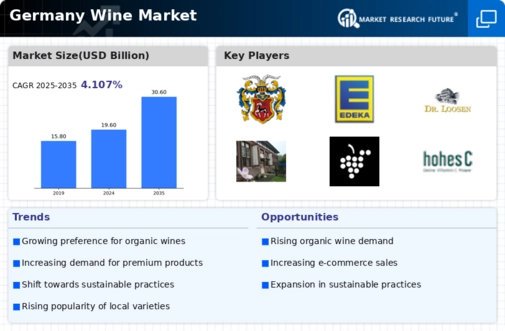Growing Interest in Wine Tourism
The wine market in Germany experiences a notable boost from the increasing interest in wine tourism. As consumers seek immersive experiences, regions like the Mosel and Rheingau attract visitors eager to explore vineyards and participate in tastings. This trend not only enhances consumer engagement but also drives sales, as tourists often purchase wines directly from producers. In 2024, wine tourism contributed approximately €1.5 billion to the local economy, indicating a robust link between tourism and the wine market. The rise in wine festivals and events further supports this growth, creating opportunities for wineries to showcase their products and attract new customers.
Sustainability Initiatives in Winemaking
Sustainability initiatives are becoming increasingly prominent within the wine market in Germany. Wineries are adopting eco-friendly practices, such as organic farming and water conservation, to appeal to environmentally conscious consumers. This shift not only enhances brand reputation but also aligns with the growing demand for sustainable products. In 2025, it is anticipated that around 30% of wineries will implement certified sustainable practices, reflecting a commitment to environmental stewardship. This trend may lead to increased consumer loyalty and potentially higher sales, as more individuals prioritize sustainability in their purchasing decisions.
Health Consciousness and Wine Consumption
The wine market in Germany is influenced by a growing trend towards health consciousness among consumers. Many individuals perceive moderate wine consumption, particularly red wine, as beneficial due to its potential health advantages, such as antioxidants. This perception has led to an increase in the consumption of lower-alcohol and organic wines, which align with health-oriented lifestyles. In 2025, it is estimated that organic wine sales will account for around 15% of the total wine market, reflecting a shift towards healthier options. This trend suggests that wineries may need to adapt their offerings to cater to health-conscious consumers.
Innovations in Wine Production Techniques
Innovations in wine production techniques are reshaping the wine market in Germany. Advances in technology, such as precision viticulture and fermentation processes, allow winemakers to enhance quality and efficiency. These innovations not only improve the taste and consistency of wines but also reduce production costs. As a result, wineries can offer competitive pricing while maintaining high standards. In 2025, it is projected that the adoption of new technologies will increase overall production efficiency by approximately 20%, thereby positively impacting the wine market. This trend indicates a potential for growth as consumers increasingly seek quality wines at accessible prices.
Diverse Consumer Preferences and Wine Selection
The wine market in Germany is characterized by diverse consumer preferences, which significantly influence purchasing behavior. With a wide range of wine styles, from sparkling to still, consumers are increasingly exploring different varieties and regions. This trend is evident in the rising popularity of lesser-known wine regions, which offer unique flavors and experiences. In 2025, it is expected that sales of wines from emerging regions will grow by approximately 10%, indicating a shift in consumer interest. Wineries that adapt to these changing preferences by diversifying their offerings may find new opportunities for growth in the competitive landscape of the wine market.




















Leave a Comment